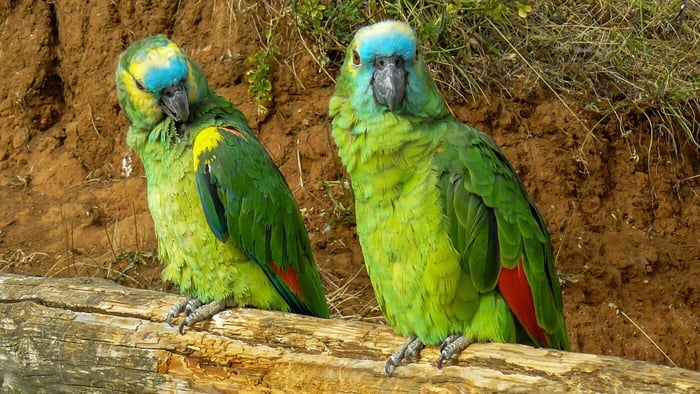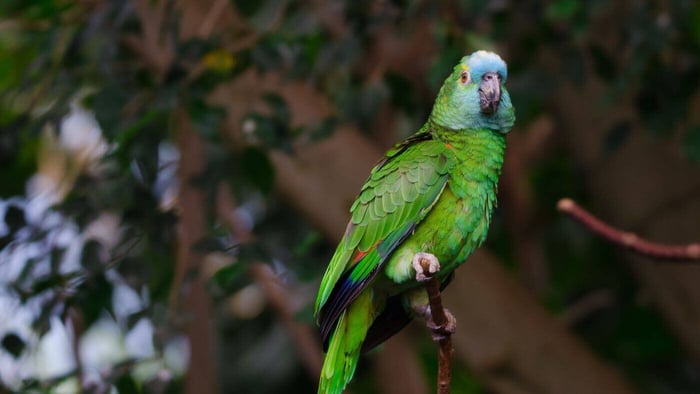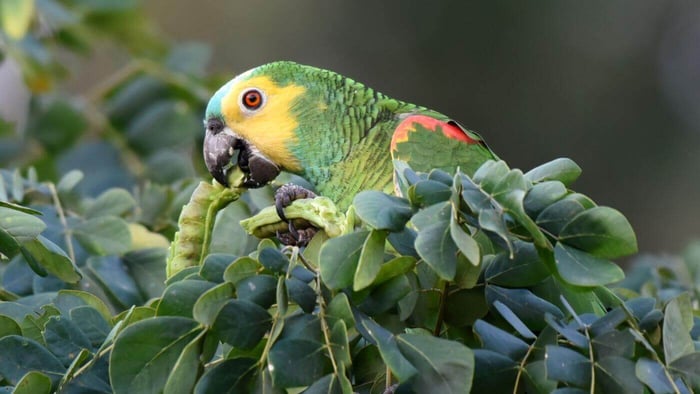Blue-Fronted Amazon Profile & Care Guide
| Common name: | Blue-fronted Amazon, turqoise-fronted Amazon |
| Scientific name: | Amazona aestiva |
| Length: | 36 cm/14.5" |
| Weight: | 400 - 500 grams |
| Lifespan: | up to 50 years |
| Range: | Southeastern Brazil, Paraguay, Bolivia and Northern Argentina |
| Noise level: | High - Loud! |
BLUE-FRONTED AMAZON NATURAL HABITAT

Blue-fronted Amazon – Amazona aestiva is naturally found in South America, specifically in the countries of Brazil, Bolivia, Paraguay, and Argentina. In its wide range, the species isn’t picky about habitat: it occurs in anything from scrubland to savannah, woodland, palm forest and even cities and parks.
Wild blue-fronted Amazons feed on a variety of seeds and fruits, like palm fruit and cactus fruit and seeds. They will also raid farms, eating crops like corn, sunflower seeds, and fruits. They mostly nest in hollow trees.
Unfortunately, the IUCN Red List has marked the blue-fronted Amazon as a Near Threatened species, noting that the population size is decreasing. Poaching for the pet trade is common in its natural range, but this isn’t the biggest issue. More serious threats include local agricultural practices, logging, and climate change.
INTELLIGENCE & PERSONALITY
Blue-fronted Amazon parrots are quite intelligent. They can learn tricks and love exploring, discovering new things and solving simple puzzles for food. They’re also highly social and truly enjoy being the centre of attention. Amazons crave a strong emotional connection and love spending quality time with their owners, often delighting them with their playful and comical behaviour.
Do keep in mind that, like many parrot species, blue-fronted Amazons can be a bit moody at times. They need plenty of attention, as they can become somewhat aggressive if not trained and handled well from a young age. So it’s important to put in the time and effort early on to make sure you and your feathered friend get along well.
BLUE-FRONTED AMAZON TALKING ABILITY & NOISE LEVEL
Good, towards excellent! Amazons in general are quite adept at learning to repeat sounds, tunes, words, and even full-length phrases. Don’t buy a parrot just because you hope it’ll talk, though: it’s highly individual, and some birds are simply not interested.
Also, be sure to consider this species’ noise level before getting one. It’s not all “Polly want a cracker” – parrots are very loud, and Amazons like this one are no exception. Even a healthy and happy parrot will spend part of the day screaming just because it can.
FEEDING & SUPPLEMENTS
As with all pets, it’s to provide your Amazon parrot with a balanced and varied diet. Its daily meals should include a wide range of fresh foods like fruits and vegetables, alongside a staple pellet diet. Classic seed mixes can form a part of your bird’s diet, but they’re too fatty to feed as a staple.
Remember, these parrots can get bored if they eat the same food day in, day out, so mixing up their meals is important for both their physical and mental well-being. You can also present foods in different manners, like by skewering fresh fruit and veg on a hanging kabob or by using foraging toys.
Be mindful of portion sizes and try to steer clear of high-fat foods, as these birds are prone to becoming overweight. Obesity is one of the number one killers of domestic parrots! Use sunflower seeds and fatty nuts as treats only.
Lastly, it goes without saying that fresh, clean water should always be on hand. To maintain hygiene, make it a daily routine to wash both the food and water dishes.
HOUSING FOR YOUR BLUE-FRONTED AMAZON

When selecting a cage for your blue-fronted Amazon parrot, aim for the largest size you can find space for in your home. As a general guideline, the minimum dimensions for the cage should be 48″ x 30″ x 30″.
Bigger is always better, though, and do keep in mind that this minimum size only applies if your bird can spend multiple hours a day outside of its cage. If you want it caged at all times, you’ll have to provide a large aviary instead.
The placement of the cage is also important. Your bird’s “house” should be situated in a part of the home where the bird will have ample opportunity for social interaction, as these birds thrive on contact with people. Do avoid drafty spots like hallways or places that might have fumes, like the kitchen. Most parrot owners opt to keep their bird in the living room.
The cage should contain a variety of natural wood perches and sturdy Amazon parrot toys. You can also opt to purchase a parrot stand or play gym for your bird to hang out on while it’s outside of its cage.
BLUE-FRONTED AMAZON FEATHER PLUCKING
Although it’s not typical for a well-socialized and healthy blue-fronted parrot to suffer from common behavioural issues, these parrots still require lots of mental stimulation to stay engaged and happy. Consider incorporating puzzle toys or foraging activities into your bird’s daily routine to keep its mind sharp.
To ensure a parrot’s overall well-being, they should also be given at least 3 to 4 hours of out-of-cage time every day. The more, the better! This time allows them not only to stretch their wings, but also explore and to hang out and engage with their human owners, which helps prevent mental issues and keeps obesity at bay.
FUN FACTS
- Blue-fronted Amazon parrots are medium-sized birds with an average length of about 14 to 16 inches (36 to 41 cm).
- They are named after the distinctive blue patch on their foreheads, which can vary in intensity from light blue to deep turquoise.
- There are two subspecies of blue-fronted Amazon: A. aestiva aestiva and A. aestiva xanthopteryx. The former sports red shoulders, while they’re yellow in the latter.
- Feral populations of blue-fronted Amazons exist in Brazil (outside of its natural range) and Germany, among other places.
- It’s not possible to visually tell the difference between a male and female blue-fronted Amazon parrot. If you don’t know whether yours is a boy or a girl, a DNA test can help clear things up.
- It’s usually easy to recognize a juvenile blue-fronted Amazon (before the first moult). Their colours don’t tend to be quite as vivid as those of the adults.
- They have a white eye-ring and yellow irises, adding to their charming appearance.
- Blue-fronted Amazons inhabit various habitats, including tropical forests, savannas, and woodlands.
- These parrots are known for their social and friendly disposition. They are highly social birds and thrive on interaction with their human caregivers.
- Amazons are intelligent and can be trained to perform tricks and mimic sounds and words.
- They enjoy playing with toys, and providing them with enrichment activities is essential for their mental stimulation.
- While they are not currently considered endangered, habitat loss due to deforestation and the pet trade has put some pressure on wild populations. Conservation efforts are in place to protect their natural habitats.
- Providing a variety of perches of different sizes and textures is essential for their foot health.
CONCLUSION
To sum up, blue-fronted Amazons are incredibly sturdy birds. They’re among the least prone to neurotic behaviours compared to other parrot species.
Although they can make wonderful and rewarding pets, it’s important to thoroughly understand their needs before bringing one into your home. Because of their intelligence and sometimes downright confusing emotional states, Amazon parrots are not recommended for those who are new to parrot ownership.
To view other Parrot Profiles & Care Guides, visit our Alphabetical list of Parrot Fact Sheets by visiting: https://parrotessentials.co.uk/blog/parrot-profiles-care-guides




